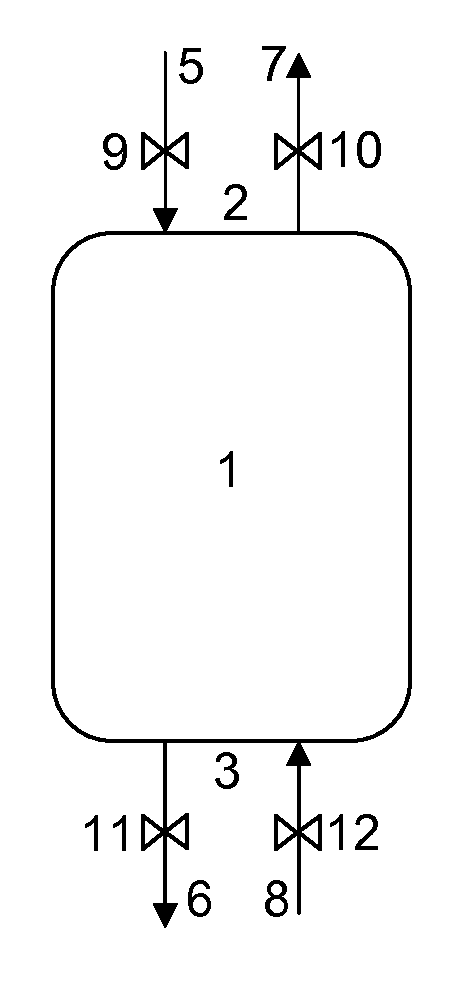Catalytic reaction with reverse-flow regeneration
a reverse-flow regeneration and catalytic reaction technology, applied in the field of chemical reaction processes, can solve the problems of combustion control problems, risk of leaving the bed, and inhomogeneous proportion of coke in the reactor
- Summary
- Abstract
- Description
- Claims
- Application Information
AI Technical Summary
Benefits of technology
Problems solved by technology
Method used
Image
Examples
example 1
According to the Invention
[0166]A reaction tube (1) made of 316L stainless steel, having an internal diameter of 22 mm and a height of 1 m is submerged vertically in a salt bath (KNO3, NaNO3, NaNO2 eutectic mixture) provided with a resistance heater and agitated by nitrogen bubbling. This device makes it possible to efficiently carry out the heat exchanges with the reactor. The temperature inside the reactor is monitored by 14 thermocouples located in a thermocouple sheath having an external diameter of 4 mm positioned in the center of the reaction tube. The reaction tube is charged with 0.337 liters of a PW / TiO2 catalyst, prepared according to example 1 of patent application WO 2013 / 18915.
[0167]In a reaction phase, a positive displacement pump and 2 mass flow regulators make it possible to respectively send a mixture of glycerol / water, nitrogen and air via a line (5) into an electrically heated vaporizer electrically connected to the end (2) of the reactor located at the top thereo...
example 2
Comparative
[0177]The conditions from example 1 between 0 and 24 h are reproduced.
[0178]The regeneration step is carried out from t=2 h to t=4 h without flow reversal.
[0179]From t=2 h to t=2 h 05, the pressure in the reactor is reduced to atmospheric pressure and the reactor is sparged with a stream of 416 Nl / h of nitrogen via the line (5). The regeneration phase is then started by injecting, at atmospheric pressure, a stream of 169 Nl / h of an air / nitrogen mixture containing 3.3% by volume of oxygen into the top end (2) of the reactor via the line (5). The temperature of the molten salt is brought to 315° C. It is observed that the temperature in the catalyst bed passes through a maximum of 337° C. at the start of regeneration (“hot spot”) then decreases. Starting from t=3 h, 169 Nl / h of an air / nitrogen mixture containing 7% by volume of oxygen is injected. At t=4 h 30, the temperature of the molten salt is reduced to 295° C.
[0180]The conditions of example 1 between 4 h and 6 h are t...
PUM
| Property | Measurement | Unit |
|---|---|---|
| temperature | aaaaa | aaaaa |
| temperature | aaaaa | aaaaa |
| boiling point | aaaaa | aaaaa |
Abstract
Description
Claims
Application Information
 Login to View More
Login to View More - R&D
- Intellectual Property
- Life Sciences
- Materials
- Tech Scout
- Unparalleled Data Quality
- Higher Quality Content
- 60% Fewer Hallucinations
Browse by: Latest US Patents, China's latest patents, Technical Efficacy Thesaurus, Application Domain, Technology Topic, Popular Technical Reports.
© 2025 PatSnap. All rights reserved.Legal|Privacy policy|Modern Slavery Act Transparency Statement|Sitemap|About US| Contact US: help@patsnap.com

